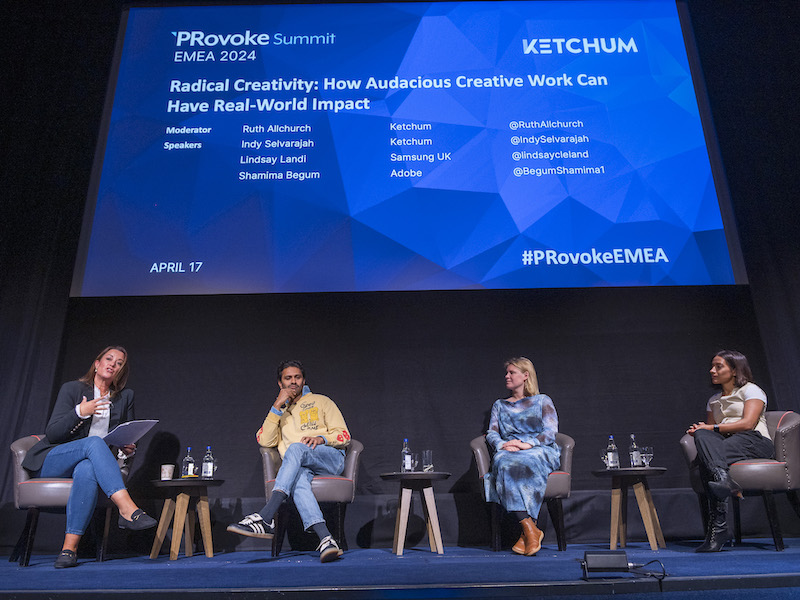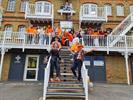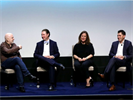Maja Pawinska Sims 25 Apr 2024 // 8:15AM GMT

LONDON — Speakers from Ketchum, Adobe and Samsung discussed how bold creative ideas and craft can address and amplify real-world social issues at the EMEA Summit in London last week.
In a panel led by Ketchum’s new UK CEO Ruth Allchurch, the panel first talked about how they define radical earned creativity. Ketchum’s chief creative officer for global markets, Indy Selvarajah, said creatives don’t necessarily set out to create radical work: “It’s more about looking at culture sideways. That allows you to connect the dots in an interesting way and leads to creative work that doesn’t have to be militant or extreme, but will be interesting, intriguing and effective.”
Samsung UK head of PR and communications Lindsay Landi said that a creative idea in itself might not be radical, but can be unexpected in the context of the brand or the cultural moment, and must still have impact: “You can’t be radical for the sake of it, the work has to have a clear impact and purpose; otherwise, you have a bold idea, but is it doing anything?”
Also on the panel was Adobe’s head of corporate communications for EMEA, Shamima Begum, who defined radical creativity as “something that leaves a lasting impression and creates an emotional connection with the audience.” She said: “It’s what lots of brands are seeking to do, but it’s really hard to land right; it has to be authentic to the brand to be long-lasting and impactful.”
The panel dissected two examples of impactful creative work for the two brands: Samsung’s ‘Fine Line’ campaign, which looked at cultural name bias in the workplace, and Adobe’s ‘Dream Bigger’ campaign around its sponsorship of the Women’s FA Cup, both of which grew out of the brands’ values and mission around making a difference and their intention that the work had an intentional societal legacy.
Selvarajah said of the campaigns, both of which were based on a hero film: “There’s something to be said for a simple construct that’s pared back, beautifully filmed and leads to real people talking authentically. It’s about driving work that is engaging to look at, crafted really well and people will share it, but there has to be a degree of effectiveness, or there’s no point us doing it.”
In terms of how brands and their PR teams use data-based insights as inspiration for bold creative ideas and ensure the emotional resonance of their work, Selvarajah said: “The way we approach it has to be really singular. It’s easy to throw everything interesting in, but then what comes out at the end isn’t clear. You need to latch on to one genuine, real insight: the single most important thing we’re trying to say. It’s hard – and you have to be slightly cut-throat.
“You may have amazing data and analytics and that’s important and helpful, but you know in your gut when you see the one piece of insight and get excited. That’s the path to work that’s really powerful and effective.”
When it comes to measuring real-world impact, the panellists agreed that beyond immediate engagement metrics, evaluating the long-term results of creative campaigns – both on the brand and on society, including factors such as changing perceptions and behaviour – was critical.
Allchurch asked the panel if it was possible “to create one exceptionally radical piece of creative work and for that to have real world impact, or does it have to be part of an ecosystem?”
Adobe’s Begum said: “You can, but it depends on the brand. Some brands people relate to because it’s part of their everyday lives and world, like some apparel brands, but it’s usually difficult to show why you need a brand in your life. In today’s world, even a 90-second video is too long, so it does need to be something broader so you can slice and dice it across social and earned media.”
At Samsung, Landi agreed: “It’s very rare. Viral moments don’t happen very often. If it’s not a 360-degree approach it can seem random, if you are going down one route with PR but social and paid are saying different things, it begs questions as to how committed the brand is.”
Selvarajah said while the lauded Guinness ‘Surfer’ campaign from 1999 had achieved huge impact through one bold activation, in today’s media landscape brands needed a suite of work from one point of view that can be filtered in different ways: “A film is always a good way of getting attention when it’s beautiful and powerful, but you also need other facets.
“A film is your ‘bang’, and people will share, but you have to keep it going and everything underneath it still needs to happen – we’re always pushing clients and saying ‘what else can we do?’ I don’t think one film can do the job anymore; a 360 integrated approach is much more powerful.”
Finally, the panel talked about how to get the best out of the client-agency relationship in producing bold creative work. At Adobe, Begum said: “When I was agency-side, the clients I loved to work with were where I felt part of their team. I’m open and honest and you really have to work together as one team, when it comes to an idea, the agency can’t think they’ve got it nailed, it can only get bigger and better by working with the client.
“For every bit of content, you need to treat the agency of part of the brand. Clients can be ruthless and agencies can be dismissive, but as long as there is respect there you can deliver great work.”


































.jpg)

















